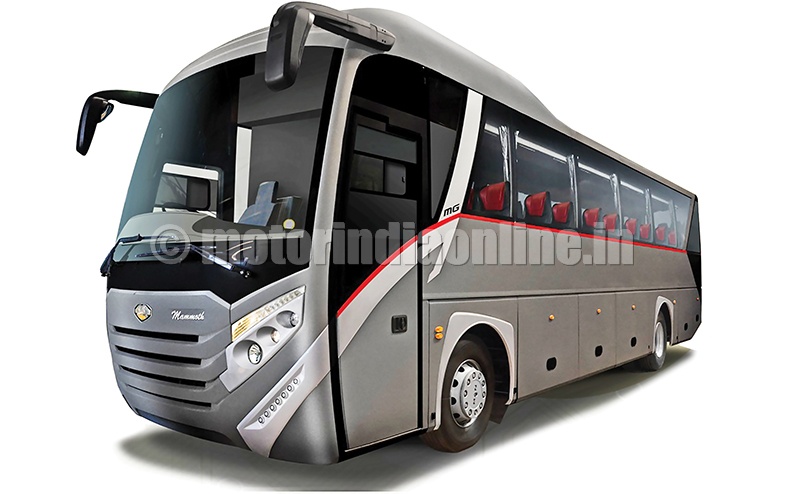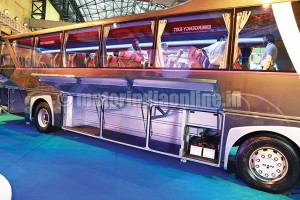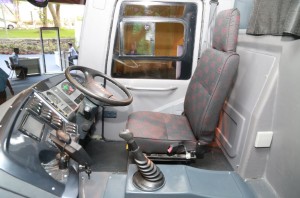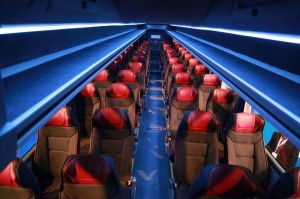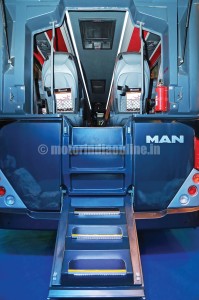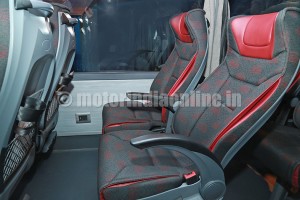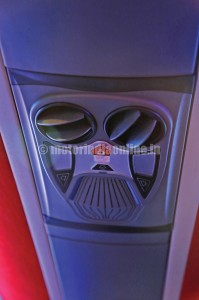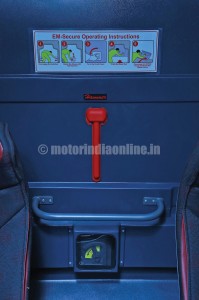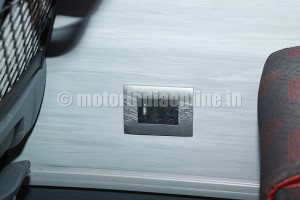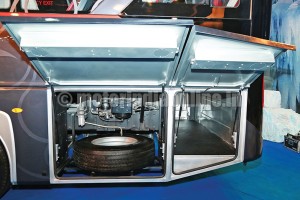Alma Motors, part of the MG Group, unveiled its first-ever luxury premium coach ‘MAMMOTH’ in the recently concluded Busworld 2015 show in Mumbai. The MAMMOTH has been developed and conceptualized by the MG Group in a strategic partnership between Alma Motors and MAN Trucks India. The entire project, which includes important contribution from different MG Group arms – West & Deccan, MG Composites and MG Grey Engine, aims to provide an optimum delivery on sales and services that the two partners will closely work on.
With MG Group having a strong relationship with many leading OEMs in the country, it was a natural choice for MAN to partner them for the development of its all-new coach on the CLA 16.22 chassis.
MG Group has very good presence in the economy, school and staff bus segments while the company has a wide range of coaches as well. With all experience put together, the MAMMOTH has been designed completely in-house with necessary approvals from MAN. The entire design and engineering of the coach, certified by MAN, has been done by West & Deccan, the design arm of the MG Group, offering state-of-the-art design and engineering services to its esteemed customers.
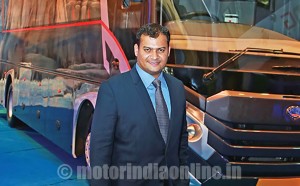
The MAMMOTH is arguably the best made luxury front-engine coach in the country till date. In every nook and corner where we could touch and feel, the quality was top notch. Gap and flush, fit and finish were so superior that the coach looked more like a manufactured one rather than fabricated. This was not just because of superior build quality but also due to choice of better quality materials as well. MG Composites, an MG Group company with a dedicated design, pattern and mould-making shop along with an integrated manufacturing setup, has taken care of all the FRP (fibre reinforced plastic) requirements of the vehicle.
There are a lot of interesting aspects in the MAMMOTH with many firsts in the Industry as well. We take a look at them in detail.
Chassis: Top draw
MAN CLA 16.22 is the first bus chassis by MAN in India. With an ever-growing demand for efficient high-capacity passenger transport in emerging markets like India, the MAN 16.22 is developed keeping in mind the requirements of developing markets. All main aggregates and components are identical with the currently-sold and proven CLA truck range and are incorporated into the MAN CLA bus chassis.
This is one of the best chassis we have seen in the domestic market so far with high levels of serviceability. The chassis is designed so well that all essential parts are easily accessible and serviceable and there are lots of clever and logical packing of aggregates in such a way that it frees up lots of space and also ensures better reparability.
This is a 12 m chassis (chassis length is 11,735 mm and with body it comes to 12,000 mm) with a wheel base of 6,200 mm. The chassis frame is ladder type with C-channel rolled section and cross-members are made of high strength steel.
The MAMMOTH is powered by MAN D-0836 BS III diesel engine with rotary FIP, developing power of 220 hp @ 2400 rpm and 800 Nm torque between 1200-1800 rpm. This is matched to a six-speed ZF 6S 850 Gearbox with a first gear ratio of 6.72. Heavy duty front axles are from MAN and rear axles are hypoid type from Meritor with RAR of 4.89 (RAR of 12 m is 5.29 – shallower the ratio better the top speed)
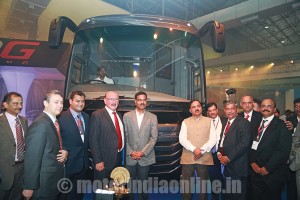
With turnaround time the top key buying factor (KBF) in inter-city coaches, higher power and good pick-up are very essential. This is the reason the driveline is optimized and is best utilizing the flat torque curve of the engine over a wide range of rpm.
MAMMOTH’s service brakes are S-Cam operated dual circuit drum brakes with ABS and automatic slack adjuster. In addition to service brakes, the vehicle has MAN-patented exhaust brakes and Voith hydraulic retarder. The hydraulic retarder has 5-stage actuation and literally eliminates the usage of service brakes for partial retardation during traffic. This eventually increases the life of service brake liners to more than double as compared to the ones without a retarder.
Front wheel bearings are sealed for life and are the first-of-its-kind in the category of front-engine buses. Also there are fairly less greasing points which reduces the cost of chassis lubrication.
The coach is pneumatically suspended all round along with anti-roll bar and provision for increasing the height by 50mm for running on bad roads. When the coach is lifted, it will have limited speed and will resume speed once the height is reduced back to normal. The chassis comes with Michelin 295/80 R 22.5 tubeless radials, a combination which promises higher tyre mileage.
The vehicle comes with a 585 L steel fuel tank located inside the frame long members and has fuel filling option on both sides. This is indeed the best place to locate the fuel tank with regard to safety. In recent times, the industry has seen several rollover accidents turning to viral fire breakouts due to fuel spilling and fuel tank bursting killing many people as a result. With the fuel tank comfortably tucked in, it will be well protected during rollover and side collision.
Placing the fuel tank inside the frame has also freed up lots of space in the WB area which will be used as luggage compartment. Usually for a front-engine bus, since the frame runs across the length, luggage space is hard to find. As a result, body builders squeeze a lot of the available area to generate free space by chopping the frame in ROH to increase the luggage carrying capacity. But in this case there is ample space for luggage storage, making the MAMMOTH the spaciest in its category, with a luggage space of around 9 cu.m.
As said earlier, the chassis has a lot of interesting tit bits. One such is the cradle-mounted AC compressor and the engine-mounted alternator making it the only front-engine chassis to have a larger in-swing passenger entry door. This is different from the traditional way of fitting the AC compressor in front-engine buses, where it is mounted in a separate bracket on the left hand side. With this, either the passenger entry door should be of out-swing type located immediately behind the front windscreen or with a quarter panel followed by an inswing door. Due to this arrangement, the entrance is usually restricted in front-engine buses. But in the case of MAMMOTH, due to better placement of AC compressor, the door has a wider aperture, paving way for easier ingress, egress and overall comfort for passengers.
The MAMMOTH’s chassis is relatively higher and has a 4-step entry to the saloon. With its high position, the bonnet is relatively flat. Remember, the previous MAN Airobus had a walkway flat floor from front to back. In fact, we do feel that the in-cabin noise could be far less as much of the engine noise would mostly be tucked below the floor.
The air drier and DDU are located in the left hand ROH just within the spare wheel mounting area. There cannot be a better place than this, as typically the DDU will be inside the frame making it difficult for servicing.
Coach: Feature-packed
MG Group has done a very impressive work on the body. While the front face and part of the body are inspired by the Mammoth of the ice age, the coach also draws design themes from it, and therefore the product is named ‘MAMMOTH’, representing the mightily huge animal. Also to be noted is the front aerodynamic roof portion which is an inspiration from the elephant.
MG Group has always been known to give unique faces to its buses, be it Leo, Scholar or PoleStar and the same holds good in the case of the MAMMOTH, with enough work carried out to bring a striking front look as evidenced by viewing the coach from the front. There is a huge grill with four horizontal slits which get merged with the headlamp embrasure. There are LED daytime running lamps, an industry first in this segment, just below the three headlamps which run parallel to their positions. The windscreen is wide and large and has a set of panoramic swing heavy duty wipers.
Enter into the coach post driver partition, and you are welcomed into a private saloon-like ambience with opulent push back seats and cushiony padding alongside the window rail providing a comfortable armrest for passengers. Every one of the lavish seats provides a passenger seat belt and through its hatrack and sidewall provides personalized reading lamps, as well as mobile and USB charging ports.
It was also said that automotive compliant point-of-use inverters will soon be a part of the list instead of regular inverters. To detail about it a bit more, the inverters convert DC to AC and it goes to all the USB charging points. Though followed by many manufacturers, this method results in high voltage current running across the length of the bus and is always a point of safety hazard. Instead the point-of-use inverter what it does is converts the DC to AC only at the point of usage, thereby greatly minimizing the safety hazards.
The point-of-use Inverter technique has been developed by MG Grey Engine, an MG Group company, involved in understanding the emerging needs of the Indian bus industry for cutting-edge technology and quality, to match the global standards in the domain of bus electronics.
A centre head rack console provides an equal and well-distributed flow of cool air for all passengers, while a pillarless head rack allows easy access to the spacious head luggage compartment above. The head racks are also pushed inside the saloon, making enough space for the main duct from the roof unit so that it doesn’t intrude into the luggage space of head rack and uniform space from front to rear is ensured.
The seats are thin and luxuriously supportive, offering great levels of comfort with foot supports. And there is something more. Unlike the regular seats which only have reclination, these seats have horizontal rails with which they can be slided horizontally as well. This is a thoughtful feature and will generate some more space for passengers without compromising on gangway width.
EM-Secure
The MAMMOTH has some more industry-first safety systems as well and this is over and above the ABS, downhill assist control and cruise control which are more of chassis features. The vehicle is equipped with a revolutionary feature called the EM (Emergency Management)-Secure which is a new benchmark as far as the safety of occupants is concerned. Traditionally, the emergency exit is always on the right hand side wall glass panel towards the rear end blocked by a row of two seats in front, making it time consuming to use in the unfortunate event of an emergency. Also it will be quite a tedious task for ladies, elders and children to quickly move out, as it involves jumping out from a height of not less than six ft.
EM-Secure, MG Group’s patented solution, provides a clear and well-marked emergency exit located at the rear end of the vehicle, which is easily approachable, unhindered as it is by any obstruction. A manually-ejected stairway, built with assist handles to provide support while descending, allows passengers of all age groups to evacuate the coach unharmed as the height between the last step and the pavement will be less than two feet. A very thoughtful feature and attention to detail includes a lit stairway which will be very useful for evacuation during night.
The MAMMOTH is squarely aimed at the premium front-engine inter-city segment which currently does not have too many contenders. It is also learnt that MAN has plans to extend the range of these chassis up to 280 hp front engine in six months and 280 hp rear engine (single and multi-axle) next year. Also in the pipeline is the all-time favorite sleeper coach variant as it is becoming more popular and a more viable option for long-distance applications. With its pricing not disclosed yet, the MAMMOTH will have very good takers, provided the company gets the product positioning and its pricing right.
The sales will be through both the MG Group and MAN, while the aftersales service support will be handled by both the companies through the geographically well-spread MAN network of more than 60 service centers across the country, assisted by its 24×7 call centers.
